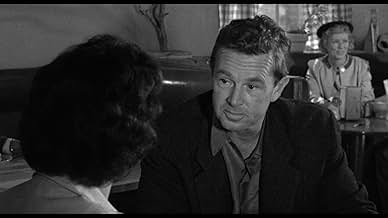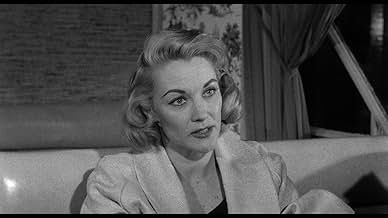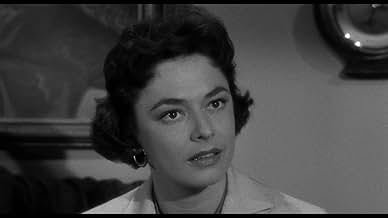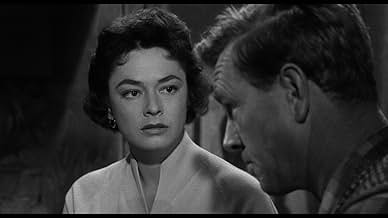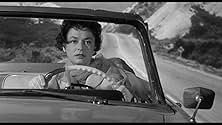NOTE IMDb
6,3/10
1,3 k
MA NOTE
Ajouter une intrigue dans votre langueDuring the 1950s, a man's car trip from L.A. to Texas turns into a Cold War espionage drama after his car breaks down and he accepts a lift from a stranger.During the 1950s, a man's car trip from L.A. to Texas turns into a Cold War espionage drama after his car breaks down and he accepts a lift from a stranger.During the 1950s, a man's car trip from L.A. to Texas turns into a Cold War espionage drama after his car breaks down and he accepts a lift from a stranger.
- Réalisation
- Scénario
- Casting principal
Karl Ludwig Lindt
- Kissel
- (as Karl Lindt)
John Frederick
- Sheriff
- (as John Merrick)
Leonard Bremen
- Collision Shop Owner
- (non crédité)
Sidney Clute
- Mechanic
- (non crédité)
Ken Curtis
- FBI Agent Jim Anderson
- (non crédité)
Harry Hines
- Motel Owner
- (non crédité)
Tom McKee
- Man from Sanitarium
- (non crédité)
Bert Stevens
- Motorcycle Cop
- (non crédité)
Avis à la une
When his car breaks down during a trip from Los Angeles to Texas, John Emmett (Sterling Hayden) meets another motorist, Ann Nicholson (Ruth Roman), who offers him a lift. He learns that she is running away from her physician, Dr. Simmons (Werner Klemperer), and the police, who want to question her about a murdered Central Intelligence Agent in Los Angeles.
Werner Klemperer? The CIA? Murder? Oh yes. While this is not one of those big budget thrillers or spy stories, it is not a bad one. You like independent film, do you not? Well, this is what it looked like in the 1950s, when you worked outside the studio system.
Werner Klemperer? The CIA? Murder? Oh yes. While this is not one of those big budget thrillers or spy stories, it is not a bad one. You like independent film, do you not? Well, this is what it looked like in the 1950s, when you worked outside the studio system.
Low-budget but suspenseful Cold War yarn, with Sterling Hayden & Ruth Roman. Hayden is gruff John Emmett, whose car breaks down in California on his road to nowhere (supposedly en route to visit his folks in Texas). The suspiciously friendly Ann Nicholson (Roman) offers Emmett a lift, as long as he'll drive some. She's going to New Mexico.
Along the way, her psychiatrist (the future Col. Klink, Werner Klemperer) & his nurse pop up; with sundry likewise suspicious characters: cops, a university dean, CIA, FBI (Ken "Festus" Curtis), & hired killers. Ann's carrying missile secrets, which are carved into a ladies' mirror. There's a fine sudden twist to the showdown with the guy for whom the missile secrets are meant.
For a low-budget thriller, the acting's surprisingly low-key. Hayden does restrained bewilderment very well: quite contrary to his lead role in "The Killing," a couple years before. Roman is also restrained in her role as a suspected spy, with secrets of her own culled from both sides of the globe. As our Dad used to say, "A goody to see again!"
Along the way, her psychiatrist (the future Col. Klink, Werner Klemperer) & his nurse pop up; with sundry likewise suspicious characters: cops, a university dean, CIA, FBI (Ken "Festus" Curtis), & hired killers. Ann's carrying missile secrets, which are carved into a ladies' mirror. There's a fine sudden twist to the showdown with the guy for whom the missile secrets are meant.
For a low-budget thriller, the acting's surprisingly low-key. Hayden does restrained bewilderment very well: quite contrary to his lead role in "The Killing," a couple years before. Roman is also restrained in her role as a suspected spy, with secrets of her own culled from both sides of the globe. As our Dad used to say, "A goody to see again!"
This is a clever directing job to make a film noir mystery into a good film.
Film noir often stumbled from being too Hollywood, with heroes and heroines automatically acting creepy just for the sake of acting creepy.
Here, we get the opposite. The best mysteries have the woman being the "woman of mystery", because that is part of being a woman, while being a man means having your mystery come out of your very straight forward approach.
Sterling Hayden often acted gruff for the sake of acting gruff. A modern day guy who thought there was always a camera on him.
But here he acts more like a believable man from the fifties, or any era before the twenty first century.
He becomes the "everyman" who is introduced to a mysterious world, which involves espionage.
The CIA and FBI are put in a likable light, which doesn't go over well with those who like the post 1965 cliché. Being 1957, this goes under the old cliché, which really wasn't around long enough to be a cliché. That's why such CIA and FBI characters are still fresh, and in the long run, more believable than the silly assassins of today.
What helps here is a great atmosphere. We get some road, and not too much of the cars. We have a few pit stops, and changing scenery, which makes this flow very well.
Film noir often stumbled from being too Hollywood, with heroes and heroines automatically acting creepy just for the sake of acting creepy.
Here, we get the opposite. The best mysteries have the woman being the "woman of mystery", because that is part of being a woman, while being a man means having your mystery come out of your very straight forward approach.
Sterling Hayden often acted gruff for the sake of acting gruff. A modern day guy who thought there was always a camera on him.
But here he acts more like a believable man from the fifties, or any era before the twenty first century.
He becomes the "everyman" who is introduced to a mysterious world, which involves espionage.
The CIA and FBI are put in a likable light, which doesn't go over well with those who like the post 1965 cliché. Being 1957, this goes under the old cliché, which really wasn't around long enough to be a cliché. That's why such CIA and FBI characters are still fresh, and in the long run, more believable than the silly assassins of today.
What helps here is a great atmosphere. We get some road, and not too much of the cars. We have a few pit stops, and changing scenery, which makes this flow very well.
Sterling Hayden, a guy stuck in the middle of the desert with a broken down car, agrees to help drive Ruth Roman, a nervous woman in a hurry, to Santa Fe. In doing so, he takes the first of FIVE STEPS TO DANGER.
A lot of movies made in the 40s and 50s, intentionally or not, end up celebrating the glories of the American Road, presumably because filming on the highway was cheaper and easier than building a set. This one, featuring views of mid 50s cars, gas stations, roadside dives, vacation lodges and hotel lobbies, is better than most at showing the real look of roadside America, 1955. Additionally, for the first half of the movie, the plot is pretty good, too, as the filmmaker does a decent job of sowing doubt as to whether female lead Ruth Roman is just a gal with a case of nerves, or a dangerous femme fatale. Unfortunately, as is the case with a lot of B films, the premise is better than the execution, and the ultimate implausibility and banality of the goings on makes the second half of the film less interesting. But the rather good start to the movie will probably keep you interested enough to stay to the end, where all is explained by the good-hearted CIA agent.
If you are a sucker for midcentury cool or low budget crime dramas, this one is for you. But don't expect a brilliant ending, or a good performance from Werner (Col. Clink) Klemperer.
A lot of movies made in the 40s and 50s, intentionally or not, end up celebrating the glories of the American Road, presumably because filming on the highway was cheaper and easier than building a set. This one, featuring views of mid 50s cars, gas stations, roadside dives, vacation lodges and hotel lobbies, is better than most at showing the real look of roadside America, 1955. Additionally, for the first half of the movie, the plot is pretty good, too, as the filmmaker does a decent job of sowing doubt as to whether female lead Ruth Roman is just a gal with a case of nerves, or a dangerous femme fatale. Unfortunately, as is the case with a lot of B films, the premise is better than the execution, and the ultimate implausibility and banality of the goings on makes the second half of the film less interesting. But the rather good start to the movie will probably keep you interested enough to stay to the end, where all is explained by the good-hearted CIA agent.
If you are a sucker for midcentury cool or low budget crime dramas, this one is for you. But don't expect a brilliant ending, or a good performance from Werner (Col. Clink) Klemperer.
Let's get this out of the way. IMDb and the film itself do not credit a young Jack Elam as the thug Harry, who fails to do away with the principal characters. One of the spies later refers to him as "Harry". Elam looks almost ruggedly handsome here, not the messy, bugeyed, snaggletoothed psychotic he often portrayed in later years.
The real problem with this noirish road film is that the script is severely weakened from the plot and dialog of the novel "The Steel Mirror" by Donald Hamilton. The original novel had a very intricate plot that included psychological amnesia, guilt as a result of betrayal of resistance fighters in France in World WAr II, more fleshed out characters and motivations, etc. Kessler, the producer, director, and screenwriter failed to make anything of his material leaving the actors trying to salvage a dull script. Had this film been done by one of the noir specialists of the 40s it probably would have been a different film. If you can hunt down Hamilton's original version it is a fine read. I salute Sterling Hayden, Ruth Roman, and Werner Klemperer for their efforts.
The real problem with this noirish road film is that the script is severely weakened from the plot and dialog of the novel "The Steel Mirror" by Donald Hamilton. The original novel had a very intricate plot that included psychological amnesia, guilt as a result of betrayal of resistance fighters in France in World WAr II, more fleshed out characters and motivations, etc. Kessler, the producer, director, and screenwriter failed to make anything of his material leaving the actors trying to salvage a dull script. Had this film been done by one of the noir specialists of the 40s it probably would have been a different film. If you can hunt down Hamilton's original version it is a fine read. I salute Sterling Hayden, Ruth Roman, and Werner Klemperer for their efforts.
Le saviez-vous
- AnecdotesFilmed before, but released after Ruth Roman's fateful trip aboard the luxury liner, Andrea Doria. The ship collided with another and sank on July 26, 1956. Miss Roman and her young son were among the survivors. During their rescue, they became separated and she arrived in New York before her son did. She was hounded by the press and paparazzi while she waited for her son's ship to arrived at the dock.
- GaffesAt the motel where Ann and John have a handyman bring them food and a hacksaw, there is no lock on the door to their room - not a chain or deadbolt or even a lock in the doorknob.
Meilleurs choix
Connectez-vous pour évaluer et suivre la liste de favoris afin de recevoir des recommandations personnalisées
- How long is 5 Steps to Danger?Alimenté par Alexa
Détails
Box-office
- Budget
- 500 000 $US (estimé)
- Durée
- 1h 21min(81 min)
- Couleur
Contribuer à cette page
Suggérer une modification ou ajouter du contenu manquant



